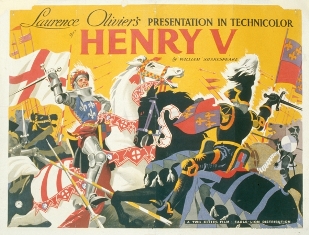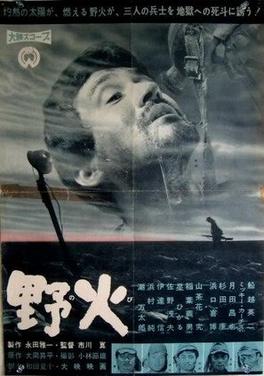Branagh released his version in 1989. He wisely chose not to try to duplicate Olivier’s wonderful vision of the play within a movie. His movie opens with the Chorus (Derek Jacobi) on a deserted sound stage. He throws open doors to launch the story in movie form (not as a play). The Archbishop’ discussion of Salic Law in front of Henry and his council is treated seriously unlike in Olivier’s. The arrival of the French ambassador with his mocking tennis balls is answered with brewing, but restrained anger by Henry.
Branagh not only has the scenes following Bardolph, Pistol, and Nim, but throws in some flashbacks to the “wastrel” Harry’s nights with Falstaff. These scenes are taken from Shakespeare’s Henry IV. They make it easier to understand Henry’s transition from immature prince to mature king. Branagh also adds a scene from the play that does not appear in Olivier’s version. The scene depicts Henry uncovering treachery by three of his nobles. He sets them up by getting them to argue for strict punishment for a soldier who spoke against the king. We see the keen intelligence of Henry in this great scene.
The siege of Harfleur is filmed at night and has a ghastly tinge to it. Henry gives his “Once more into the breach…” speech which more clearly results in another failed assault than in Olivier’s. Also, Branagh includes Henry threatening rape and killing if the city does not give up. Branagh was obviously not restrained by the need to make Henry a saintly hero for the British people to rally around during the dark days of WWII, like Olivier was.
The scene with Princess Katherine and her maid are similarly done without subtitles and are equally playful and light. Emma Thompson is a better actress than Renee Asherson, but not decisively so in this role.
The march to Calais is more realistic with its rain and mud. Branagh decided to include the hanging of Bardolph for violating his no looting policy. The scene did not fit Olivier’s goal for the film, but it is apparent Branagh was determined to expose every aspect of Henry’s complex personality. He even goes so far as reenacting a hanging that is just mentioned in the play.
The night before the battle focuses on the arrogance and hubris of the French knights and the gloom of the British foot soldiers. Branagh’s Henry roams the campfires more realistically incognito. His reaction to criticism of the king by common soldiers is more appropriately seething.
Branagh’s “Band of Brothers” speech is similarly staged, but better orated with a beautiful pairing of words with music. The reaction of the soldiers is also more integral to the scene than in Olivier’s. Branagh actually spits as he declaims. No second take for him.
In the battle, we see the fear in the British soldiers’ eyes. There is no cavalry charge and we jump straight into the melee. It is realistically muddy. Branagh makes the questionable decision to have the archers firing volleys into the melee, thus subjecting the British knights (including Henry) to friendly fire. This is not only tactically unsound, but inaccurate historically as the archers had ceased fire when the knights closed. By this time in the battle, the archers were wading in with their daggers and mallets. Branagh gets to this, adding the nice touch of some archers looting the bodies. Branagh does a good job of depicting the chaotic nature of a medieval battle with its “fog of war”. Some of the action is in slow motion, naturally. York dies a graphically violent death here where in Olivier’s version we only see the corpse. The French Constable is rescued and soon after dies. There is no duel with Henry. Some French knights break through to attack the baggage train and kill the boys (including Christian Bale). This is similarly inaccurate to Olivier’s, but Branagh does not imply the villains were from the French leadership group. At this point the Herald arrives to tell Henry the day is his. Henry does not return to the battle to get vengeance for the dead boys because the battle is over. Instead Henry carries the Boy’s dead body as a hymn swells in the background. The movie should have ended here! There are 17 minutes of denouement left, unfortunately.
The wooing of Kate is not remarkably different than in Olivier’s version, but Branagh and Thompson give the dialogue a more genuine feel. This is a weak part of the play and the movie does its best to reduce the embarrassing aspects of the whirlwind courtship.
It may seem at this point that I find Branagh’s version to be superior, but not so fast. Let me specifically comment on various elements.
1. the opening – Olivier wins with his brilliant decision to start the play in the Globe Theater
2. humor – Olivier wins with his Archbishop explaining Salic Law and several characters (especially Pistol) hamming it up; there is little humor in Branagh’s more serious version
3. the French king – Olivier’s king is more accurately addled
4. Harfleur – Branagh’s siege is more accurate and has better action
5. Kate’s English lesson – Thompson over Asherton; Geraldine McEwan over Ivy St. Helier
6. the night among the campfires – Branagh
7. Band of Brothers Speech – Branagh is more rousing
8. the battle – Branagh, although both include some inexcusable inaccuracies; Branagh’s volleys into the melee are trumped by Olivier’s ridiculous duel between Henry and the Constable; Olivier’s cavalry charge is wonderful, but the ambush by tree-jumping archers cancels some of it; Branagh by a nose because you have to have a lot of mud if you are doing Agincourt
9. the wooing – Branagh is less cringe-inducing
10. sets – Olivier wins with his imaginative transitions from the Globe to sets based on “The Book of Hours” to the great outdoors and back again
I also have to mention that one of my favorite characters in Shakespeare is Fluellen and Ian Holm’s portrayal of him is outstanding. In fact, truth be told, the acting in Branagh’s version is uniformly better than in Olivier’s version. I know Olivier was partially trying to replicate the acting style of Elizabethan theater, but the hamminess of some of the performers is too over the top. And at the risk of blasphemy, I feel Branagh makes a better Henry than Sir Laurence Olivier.
In conclusion, both versions are masterpieces and stand on their own as tours de force for their actor / directors. Each put his own stamp on the play. It is remarkable that two movies with virtually the same dialogue could be so different and yet faithful to the play. Olivier deserves tremendous credit for his unorthodox approach to the Bard, but Branagh’s decision to not try to top Olivier is commendable. Branagh’s approach is much more orthodox, but the execution could not be better. Each movie is reflective of its times. Olivier emphasizes the aspects that would inspire Englishmen to defeat the Nazis. Branagh is aiming at a modern audience and his nuanced portrayal of the king is appropriate for 1989 and actually closer to Shakespeare’s Harry. His inclusion of scenes that Olivier purposely left out makes his film more complete.
My recommendation is to watch both. It would be foolish to pick one over the other. However, if you insist on one – Branagh’s is slightly superior.
Branagh's BOB
Olivier's BOB
Branagh at the breach


